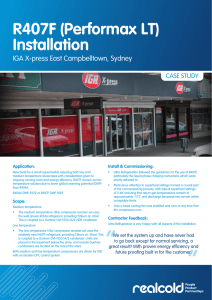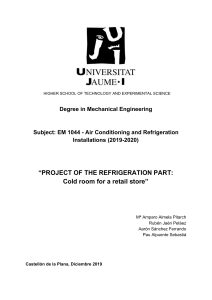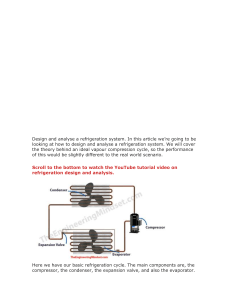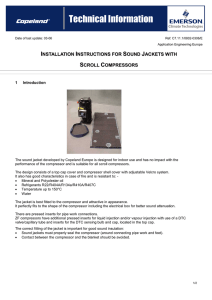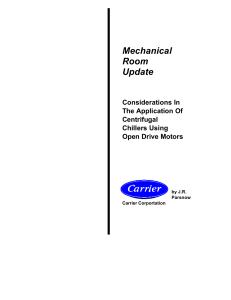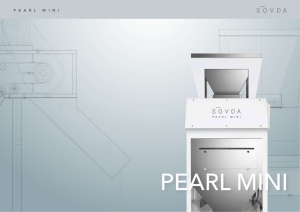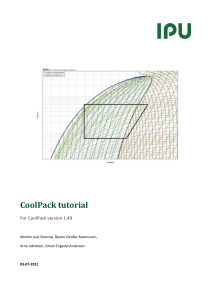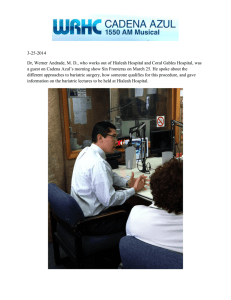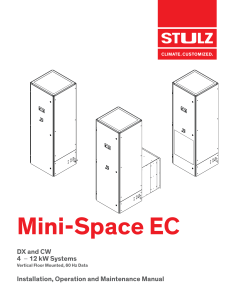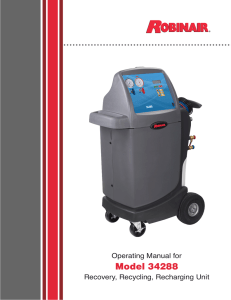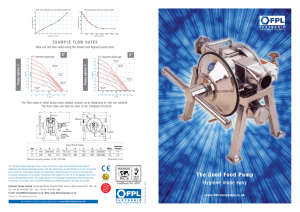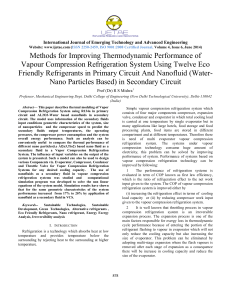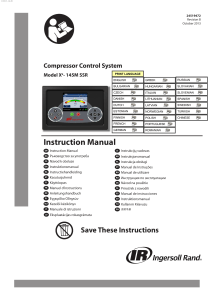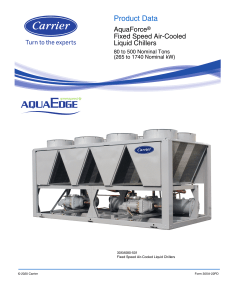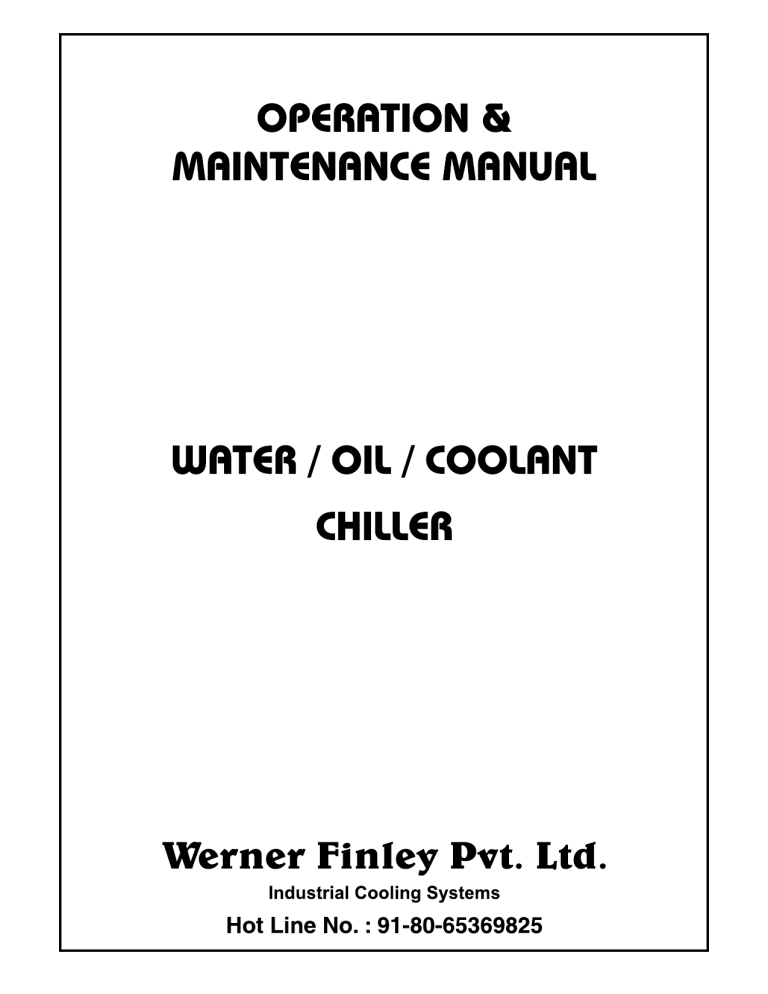
Werner Finley CONTENTS Description Chapter Page No 1, 2 3 4 Chapter 1 Certificates Design data Operating limits Chapter 2 Introduction General description Inspection Handling and lifting 4 4 4 5 Chapter 3 Locating Foundation & Anti-vibration Mounts Location Tips 5 5 5 6 Chapter 4 Liquid Piping Typical Piping Layout Immersion Type Installation Check Report 7 8 9 10 Chapter 5 Start-up & Operation Preparing the system for start up. Start up & operation Emergency Stop Sequence of Operation 11 12 13 14 Chapter 6 Refrigeration Refrigeration cycle standard controls 15 16 17 Chapter 7 Trouble Shooting Chart 19 Maintenance Safety System Maintenance Tips for preventive maintenance Schedule & warnings 21 23 24 25 Service System Service Refrigeration Line Service 26 27 Temperature Controller Dixell Subzero 30 31 Technical data Temperature conversion chart Pressure, Temperature Chart 32 33 Chapter 8 Chapter 9 Chapter 10 Chapter 11 Werner Finley Werner Finley Pvt. Ltd. Industrial Cooling Systems #9, Cauvery Nagar, Near Swayam Prabha Kalyana Mantapa, Magadi Main Road, Kamakshipalya, Bangalore 560 079. Ph. 080-23289889, 23288371 Fax : 91-80-23283191 E-mail: [email protected] TEST CERTIFICATE PRODUCT : SERIAL NO. : CUSTOMER : P. O. No. : It is certified that the above Chiller has been inspected for its specification, material inputs, workmanship capacity and performance. The results are found to be satisfactory. For Werner Finley Pvt. Ltd. 1 Werner Finley Werner Finley Pvt. Ltd. Industrial Cooling Systems #9, Cauvery Nagar, Near Swayam Prabha Kalyana Mantapa, Magadi Main Road, Kamakshipalya, Bangalore 560 079. Ph. 080-23289889, 23288371 Fax : 91-80-23283191 E-mail: [email protected] GUARANTEE CERTIFICATE PRODUCT : SERIAL NO. : CUSTOMER : P.O. No.: : We hereby guarantee to replace at free of cost any component found defective due to bad workmanship or faulty raw materials in the above supply. The defects, which occured due to transit, bad storage, misuse or mishandling of the equipment at customer's site or due to normal wear and tear will not be entertained. This guarantee will be valid for a period of twelve months from the date of supply. For Werner Finley Pvt. Ltd. 2 Werner Finley DESIGN DATA 01. UNIT SERIAL NO. - 02. TYPE OF CHILLER Kcal/Hr 03. COOLING CAPACITY - 04. POWER SUPPLY - 1 PH, 230 V, AC, 50 HZ - 3 PH, 440 V, AC, 50 HZ 05. POWER / CURRENT - 06. APPLICATION - 07. LIQUID TYPE & QTY. - 08 CONDENSER TYPE - AIR COOLED - WATER COOLED 09. NO. OF FANS - 10. EVAPORATOR TYPE - COIL IN TANK - SHELL AND TUBE - PHE 11. REFRIGERANT - R 134 a / R 407c / R 22 / R 404a 12 PUMP - FLOW__________PRESSURE________ 13. TEMP. CONTROLLER - 14. COLOUR SEIMENS GREY - ADMIRAL GREY BLUE OTHERS 3 Werner Finley OPERATING LIMITS Standard Air-cooled, reciprocating, liquid chiller packages. Unit Description R22 / R 134a Min/Max. liquid temperature Leaving the evaporator 0 Min/Max. liquid temperature entering the evaporator. 0 12 / 30 0 C 15/ 45 LPM 12 / 20 per TR C C Min/Max. operating ambient temperatures. Min/Max. flow late of liquid across Evaporator 7 / 25 Units outside given standard operating limits are also available, for details please contact our Head Office at Bangalore. INTRODUCTION General description ! Werner Finley liquid chillers are complete, self-contained, automatic refrigeration units that are ready for installation. ! These units include the latest engineered components assembled to provide a compact and efficient Chiller. ! Each unit is completely factory assembled, wired & pressure tested before charging of refrigerant. The unit undergoes thorough load test before dispatch. Inspection ! Upon receipt of the units at site, ensure the complete shipment against delivery note or Bill and also inspect the unit for any transit damage. ! If transit damage is found, report the damage to the transporter and file for insurance claim. 3 4 Werner Finley Handling and lifting ! Always keep the unit in vertical position as per arrow displayed on the wooden box. ! Dismantle the wooden packing. ! Lifting hooks / eyebolts are provided at the top of unit. Use them for safe lifting. ! In some units where lifting hooks are not provided, sling the unit from base to lift safely. ! Handling of the unit should be done with the aid of qualified personnel's who are familiar and experienced with this type of equipment. Note: Physical damage to unit after acceptance will not be covered for rework under warranty LOCATING Foundation andAnti Vibration Mounts ! Werner Finley units have very minimum vibration units and do not require any special type of mounting. ! These units can be set directly on the floor or rooftop or any platform with adequate support system. Shelter to be provided in case of outdoor installations. ! Anti vibration mounts can be used and can be of Neoprene rubber material. ! For Immersion type units beading should be provided on the frame where it is to be mounted, to avoid metal to metal contact. Location ! Each side of the unit must be accessible for periodic maintenance and service work. ! The unit should maintain a good clearance from the surrounding walls for good air exchange. ! The area should have good ventilation system or exhaust system. 5 Werner Finley Location w.r.t. clearances from adjacent walls / obstructions 1m 1m 1 - 1.5m Note: Upper side clearance should be atleast 2 m from the top of the chiller Tips on Location Selection ! In air-cooled units, condenser air inlet and condenser fan air discharge must be free from any obstructions. ! Units that are not given enough clearance, will experience coil starvation and hot air re-circulation and would affect the performance of the chiller. ! Hence, free air supply and free hot air ventilation is a must at the site of installation of an air-cooled chiller. ! The discharge of the condenser is hot and is exhausted out through the cut out provided (normally top). ! If required, ducts can be used to vent this hot air out. ! Aprofessional should take up the ducting work 6 Werner Finley LIQUID PIPING In most chillers, the pump is included in the package and only the end connections are to be made at the site. ! The pipeline could be of flexible hose or pipe one depending on the pressure and preferences. Flexible hose should be properly clamped to avoid leakage. ! Flexible hoses can subjected to pinching if supports are not provided. ! The inlet/outlet pipeline diameters should not be reduced or increased. ! Rigid pipeline should be of stainless steel or any non corrossive material pipe to avoid rusting. ! Provide isolation valves at inlet / outlet connection to chiller. ! Providing vibration isolators of the right diameters at the inlet/outlet of the chiller, where ever the piping its rigid. ! Providing an air vent in the pipeline is a good practice to vent the trapped air in the pipeline during startup. ! It is recommended to use a wire mesh strainer at the inlet to chiller. The size of the strainer should be at par with the rate of flow of impurity through the pipeline running above the tank. ! NRV [Non Return Valve] should be provided in case of lengthy pipelines running above the tank. ! In case, where flow consistency cannot be assured, it is highly recommended to install a flow switch in discharge pipeline and interlock the same with the chiller. ! As much as possible try giving a positive suction to the pump. If not, use a self priming pump with a foot valve at the suction. Also provide an opening with a valve in the discharge line for priming the pump. ! Please inform our engineering team well before if the pump is subjected to negative suction. ! Sharp and too many bends will create a back pressure and reduce the liquid flow through the system. ! If there is a heavy condensation, insulation to be provided for the liquid lines. ! Using unions or flanges of correct sizes wherever necessary helps for easy maintenance. Note: Werner Finley will not be responsible if chiller or pump fails or malfunctions due to foreign particle entry, reduction in flow, bad piping, pump starvation, freezing of heat exchangers, etc. 7 Werner Finley Typical Piping Layout 5 6 2 3 4 1 7 LABELS 1 2&5 3&6 4 7 8 WATER PRESSURE GAUGE VALVES VIBRATION ELIMINATOR Y-STRAINER AIR VENT Werner Finley Immersion Type Chiller ! Complete coil to be immersed in fluid. ! Electrical float switch is a must. ! Stirrer for larger tank is a must for agitation. ! Lifting arrangement is a must for periodic coil cleaning. NOTE: SOFT WATER OR DM WATER CAN BE USED AS THE FLUID. PEROIDIC CLEANING OF TANK AND REFILLING OF FRESH WATER ISAMUST. FLUID CONTAMINATION CAN LEAD TO PUMP FAILURE, FREEZING OF HEAT EXCHANGERS & EVENTUALLY COMPRESSOR FAILURE. FAILURE DUE TO ABOVE REASONS WILL VOID THE CHILLER WARRANTY. 9 Werner Finley INSTALLATION CHECK REPORT Customer : .................................................................................... Unit SL. No. : .................................................................................... Unit Cap : .................................................................................... Sl. No. PARTICULARS 01 In case of transit damage, has it be attended completely? Yes/No. 02 Is there any damage during installations? Yes/No. 03 Have damages as per list been attended? Yes/No. 04 Whether unit is mounted as per recommendation? Yes/No. 05 Is there free space to attend chiller? Yes/No. 06 Has the piping & insulation been done as per recommendation? Yes/No. 07 Has sufficient space been left for condenser air entry and service facility? Yes/No. 08 Sufficient space to clean evaporator? Yes/No. 09 Power supply & supply cable as per recommendation? Yes/No. 10 Sufficient space for attending electrical panel? Yes/No. 10 Werner Finley START UP AND OPERATION NOTE: DO NOT ATTEMPT TO START THE CHILLER UNTILL THE FOLLOWING CHECKS HAVE BEEN COMPLETE. ! With mains disconnected, check all electrical connections in control panel. All though all connections are tightened at factory, they might have loosened up during shipment, which may cause system to malfunction. ! Check the actual line voltage to the unit to make sure it is the same as specified on the chiller specification plate within _+10% and that the phase voltage imbalance does not exceed 2%. Verify that adequate power supply & capacity is available to meet the required load. % Of Voltage imbalance 100 x Max. Voltage deviation from average average voltage The maximum voltage deviation in the largest difference between a voltage measurement across two legs and the average across all three legs. EXAMPLE a) Supply voltage is 415V Voltage across - 3PH-50 Hz RY - 410 V YB - 419 V BR - 405 V - 411.33 V Average b) Maximum deviation from average voltage RY = 1.33V; YB = 7.6V; BR = 6.33 V Hence Max. deviation is 7.6 V c) % voltage imbalance = 100 x 7.67UU 411.33 which is less than the allowable 10% imbalance. 11 = 1.86% Werner Finley ! Make sure that all interlock wiring is as per the wiring diagram provided in the control panel pouch. ! Check lubrication oil level in the compressor sight glass. The oil level before start up should be at least 1/3 of the sight glass. ! Now turn the main switch on, this will energize the crankcase heater. (Crankcase heater is available on models above 4 TR capacity) NOTE: Crankcase heaters have to operate at least 12 hrs prior to start up. Crankcase should be warm. ! In units that have suction, discharge valve on compressor and liquid line hand shut off valve, check for them to be in open condition. ! Check all liquid line valves and keep them open. Now switch on pump and check for leakage in pump & pipeline. ! Set the required flow & pressure by using the balancing valves at the discharges, by pass & return line. Measure the flow using a graduated vessel & ensure it is inline with the system requirement. START-UP & OPERATION: ! Please check whether all the MCB/MPCB are in on condition. Now once the proper flow is assured by switching on the pump, then turn on the switches for the compressor & fan simultaneously. ! The fluid temperature is now sensed & if it is higher than the set point, the comp & fan will start to operate & the crankcase heater will turn off automatically. ! Once again check the setting of the OLR, HP, LP & AFT switches for correctness. 12 Werner Finley ! Now the compressor will work to bring down the fluid temperature to the set point. Once the fluid temperature reaches set point, the compressor & fan will cut off and the pump will still be in operation. ! Again as the fluid gains temperature & raises equivalent to the set differential, the signal is taken up by the delay timer, after a preset delay of 3 minutes, the compressor & fan again cuts in to lower the fluid temperature. ! While unit is fully loaded, check suction pressure, discharge pressure, comp/fan/pump current and compressor shell temp. ! Should you face any problem, refer to the chapter on trouble shooting. EMERGENCY STOP ! Turn off the rotary switch during such situations ! Stop on weekend or temporary shut down. ! Switch off the circuit breakers in the control panel & keep the main switch on during such shutdowns. ! Extended shut down: In larger units where there is a liquid line hand shut off valve, close the valve, run the system & monitor the suction discharge pressure through gauges. Allow all the gas to pump down to the condenser side & switch off the unit. Now close the suction discharge valves in the compressor, close the liquid isolation valves as well. ! To start the unit again, follow the steps from START UP. NOTE: Crankcase heaters have to operate at least for 12 hrs before start up & the crankcase should be warm. Open all valves before starting 13 Werner Finley SEQUENCE OF OPERATION FOR LIQUID CHILLERS ITEMS Step 1 Initial checks ACTIONS REMARKS a) Check all electrical connections are tight. b) Check the supply voltage is within permissible limits. c) Check the entire refrigerant & liquid circuit valves are open. d) Check oil level in oil sight glass. e) Check flow across evaporator. f) Check compressor shell temperature. b) Shall be within 10% Step 2 Sequence of starting a) Check all safety interlocks b) Start pump & liquid flow. c) Start the unit as recommended in unit startup section b) Check pressures at pump discharge & measure flow. Step 3 Observation a) After steady operation at design condition, see that the refrigerant pressures are stabilized. b) Take all readings like comp. Suction & discharge pressures, comp/fan/pump current, comp shell temp, pump flow & pressure, air flow across condenser, etc. c) Periodical oil level check. d) Abnormal noise & vibration. e) Vibration of refrigeration and liquid pipelines. f) No switch gear components are running hot. Step 4 Stopping a) Turn off the circuit switch. b) Check for oil return in crankcase. c) Close all valves if required. 14 d) Should be 1/3rd or 1/2 the sight glass. c) Oil level should be between ½ & 1/3 of sight glass. e) Arrest all vibrations. a) It is not advisable to switch off the whole unit in one go. So use the individual circuit breakers in the panel & switch off the comp, fan, and then pump in the same order & then turn of the main switch. Werner Finley REFRIGERATION A liquid whose Saturation temperature at normal atmospheric pressure is below the temperature that is to be produced by refrigeration is chosen as the working liquid in the refrigerator and is known as refrigerant. Such a liquid will evaporate at lower temperatures and will absorb heat as it does so. This heat is extracted from the surroundings. The vapour formed in this way is compressed in a compressor. After compression the refrigerant may be in the vapour state or, in the liquid state if its temperature after compression is not greater than the saturation temperature at that increased pressure. The low temperature vapor is condensed in a condenser. As a result of condensation in the condenser, it gives off the heat in the condenser, in doing so it lowers its temperature below the surroundings. Now the condensed liquid is expanded to a lower pressure and the cycle of refrigeration is repeated. VAPOUR COMPRESSION REFRIGERATOR 15 Werner Finley REFRIGERATION CYCLE 1. Compressors are used in vapour compression cycles. It is the heart of the system and it sucks low-pressure refrigerant vapour from the evaporator and compresses it to a pressure corresponding to the saturation temperature that will be higher than the air available to condense the refrigerant. The compressor also aids to continuously re-circulate the refrigerant through the system. 2. Air-cooled condensers are heat exchangers, which reject heat from the condensing refrigerant to the atmosphere. The function of condenser in a refrigerated system is to de-superheat and condense the compressed discharge refrigerant vapour. Highspeed fans are mostly used to speed up the process. 3. At the exit of the condenser the refrigerant loses temperature but still is in highpressure state. The temperature falls down a little high to the ambient. 4. Dryers are mainly used to capture the moisture content if any mixed with the refrigerant. When the refrigerant passes through its thin filter mesh the moisture gets trapped on the silica gel and clean refrigerant flows through. 5. Throttle valve (also called as Expansion valve) is also a very important component of the vapour compression refrigeration system. The function of an expansion device is to expand the liquid refrigerant from the condensing pressure to the evaporating pressure. Also it throttles the required flow into the evaporator depending on the load conditions. Commonly used expansion devices are capillary tubes, thermostatic expansion valves and constant pressure expansion valves. 6. Any liquid when evaporates creates a cooling effect. Same applies here, when the refrigerant exits expansion valve it is partly in vapour state at low temperature and pressure. It flows through the evaporator and exchanges heat with the surroundings. 7. After exiting the evaporator it has gained heat from the surrounding media, thus lowering the temperature in the freezing compartment. This superheated vapour passes further and is drawn by the compressor, which compresses it, and delivers to condenser, thus, completing the refrigeration cycle. 16 Werner Finley STANDARD CONTROLS ![HP] HIGH PRESSURE This is a manual reset type pressure controlled electromechanical device used as a safety cutout against high discharge pressure of the refrigerant. The reset button is located on the HP/LP switch. 2. [LP] LOW PRESSURE This is an automatic reset type pressure controlled electromechanical device used as safety cutout against low suction pressure. The unit trips & resets automatically till the pressure completely drops below the desired level. 3. OILPRESSURE [COMPRESSOR LUBRICATION] In larger semi hermetic compressors there is an in-built oil pump assistant for the lubrication of the compressor. There is an oil pressure cutout switch that senses the discharge pressure of this pump & the suction pressure of the compressor & opens the compressor motor power circuit in case of a trip. The reset in this cause is done manually. 4. THERMISTOR TRIP In compressors above 5TR, the compressor motor is embeded with temperature sensor. As the motor winding temperature, exceeds the permissible limits the thermistor cuts out the power supply to the compressor motor. The reset is automatic, for which the motor has to cool naturally. As the compressor cuts off, there is an indication on the panel that remains glowing until the auto reset happens. 5. [SPP] SINGLE PHASE PREVENTER This device safeguards the chiller from: Single phasing, phase reverse & voltage imbalance. Under or over voltage ± 10%. 17 Werner Finley 6. ANTIFREEZE TRIP This is a manual reset type thermostat. As the liquid temperature falls below safety set point, the thermostat trips the compressor & the liquid pump. The reset button is located on the thermostat itself. 7. [OLR] OVER LOAD RELAYTRIP All the motors of the compressor, fan & liquid pump are wired through an over load relay. As the respective motor draws higher than the set current value, the OLR trips off the motor & an indication is generated on the panel. 8. WATER LEVELLOW In chillers with in-built tank the float switch aids in maintaining an optimum level in the tank. The whole system comes to a halt as the water level goes low and an indication on the reset push button is generated on the panel. As the water level is made up & the reset button is pushed, the chiller resumes its operation. 9. FLOW SWITCH TRIP In chillers, where flow switch is installed in the liquid circuit, the whole system trips as a lack of adequate flow.An indication is generated on the panel and resets automatically when flow is initiated. 18 Werner Finley TROUBLE SHOOTING PROBLEM Sl.No. 01 02 Unit not switching ON SPP trip POSSIBLE CAUSE ACTION > MCB/OLR are kept off when the unit is dispatched. Ensure the MCB/OLR of the unit are in ON condition. > Voltage imbalance Check voltage > > Phase Failure Incorrect phase sequence Check voltage. Interchange the phases. 03 OLR trip > > Pump, Compressor, Fan Motor taking high current Contact Vendor 04 Water Level Low > > Low water level in the tank Leaks in the pipeline Fill up the water, reset. Rectify the leaks 05 Antifreeze trip > > > > > No water circulation Pump Failure Pump suction valve closed Low load Evaporator blocked Clean the strainer Contact Vendor Open the valve Optimize load Clean Evaporator coil 06 Flow switch trip > > > > No water circulation Pump Failure Pump uction valve closed Dry running of pump Clean the strainer Contact Vendor Open the valve Prime the pump 07 Oil Pressure trip > Compressor oil pump failure > Low compressor oil Contact vendor Contact vendor 08 Thermistor trip > Compressor shell temperature > very high > Low refrigerant Allow the compressor to cool, automatic restart Contact vendor 09 Low pressure > > > > Low refrigerant Refrigerant filter choke Low load Evaporator blocked 19 Contact vendor Contact vendor Optimize load Clean Evaporator coil Werner Finley Sl.No. PROBLEM POSSIBLE CAUSE ACTION 01 High pressure > > > > > > Clogged filters Clogged condenser Condenser fan failure Hot air re-circulation Obstruction in air flow High pressure side choke Clean filters and condenser with air pressure Contact vendor Provide ventilation Clear obstruction Contact vendor 02 Unit ON but compressor not starting > Compressor on timer, initial time delay 3mins. Timer not working Thermostat device open Wait till the timer elapses. > > > > > 05 Compressor starts but makes humming noise Compressor starts but trips immediately Contact Vendor Compressor to be replaced. Contact Vendor Low Voltage Start capacitor defective Compressor windings defective High Discharge Pressure Check the voltage Change capacitor Replace the compressor. Check the voltage Change the defective accessories Contact Vendor > Low Voltage Compressor accessories defective Compressor taking high current Windings defective > > > > > Compressor not getting on. Filter clogged with dirt Compressor taking less current Compressor over heated Low refrigerant Follow instruction No. 2 Clean the filter Low Refrigerant, Contact Vendor Contact Vendor > > > > 06 Compressor accessories not working Overload Protector Tripped No continuity in compressor terminals Contact vendor Wait till temperature exceeds set temp by 20c. Accessories to be changed. > > > Contact Vendor. Contact Vendor. 07 High Temperature 09 Low Temperature > > Set temperature altered Thermostat not working Check the settings Replace. Contact Vendor 09 Freezing in Evaporator > > Improper water flow Pump failure Check for obstruction Contact Vendor 20 Werner Finley MAINTENANCE SAFETY CONSIDERATIONS Installation, starting-up and servicing of process chillers can be hazardous due to system pressures, electrical components and equivalent location viz. roofs, elevated structures, etc. Werner Finley make liquid chillers are designed for safe and reliable, when operated within design limits. When operating this equipment, use judgement and safety precautions to avoid damage to equipment, property or injury to personnel. Be sure that you understand and follow the safety precautions. NOTE: ONLY TRAINED, QUALIFIED INSTALLERS AND SERVICE METCHANICS SHOULD INSTALL, START-UP AND SERVICE THIS EQUIPMENT. SOME OF THE SAFETY TIPS: GENERAL: 1. DO NOT CLIMB over the chiller and DO NOT STEP on refrigerant lines. Broken lines can release high-pressure refrigerant and cause injury to personnel. 2. NEVER SHORT-CIRCUIT any controls in the system. 3. Care in HANDLING & RIGGING; check weight, use appropriate lifting equipment, use lifting hooks, or use base frame for lifting equipment. 4. PERIODICALLY INSPECT all valves, fittings, and piping for corrosion, leaks and damages. 5. Drain liquid completely before loosening or attending to liquid lines. 21 Werner Finley PRESSURE TEST 1. Use only dry Nitrogen. Use a regulating valve with pressure gauge. 2. DO NOT USE OXYGEN orACETYLENE, both could cause explosion. 3. HANDLE THE CYLINDERS VERY carefully. 4. NEVER EXCEED 300 PSI during pressure testing the equipment. REFRIGERANT 1. DO NOT VENT refrigerant in closed room as it could displace oxygen and cause asphyxiation. As per ASHRAE Std 15, refrigerant to be vented out in the open or through the ventilator in the plant room. 2. Though R22/R134a/R407c/404a are non-toxic, spillage of liquid refrigerant on skin & eyes could cause severe damage to the tissue. Use safety goggles and gloves. In case of refrigerant burn on skin flush with cold water immediately. If liquid refrigerant enters the eyes, IMMEDIATELY FLUSH EYES with water. Consult a physician immediately. 3. DO NOT WELD or FLAME CUT any refrigerant line before completing evacuating the refrigerant from the system. Dry Nitrogen to be used to flush final traces of Refrigerant and place to be well ventilated. Refrigerant with open flame produces toxic gases. 4. CHECK REFRIGERANT TYPE before charging into the system. In case of wrong charge, the system could get damaged or malfunctioning could occur. 5. NEVER HEAT refrigerant cylinder with open flame, ONLY use warm water (43) to heat cylinder. 22 Werner Finley Electrical: 1. DO NOT WORK ON HIGH VOLTAGE equipment unless you are a qualified electrician. 2. DO NOT WORK ON electrical components, including control panels, switches, starters or oil heaters unit you are sure ALL POWER IS OFF & NO RESIDUAL VOLTAGE can leak from capacitors or solid state components. 3. Lock OPEN & TAG electrical circuits during servicing IF WORK IS INTERRUPTED, confirm that all circuits are de-energized before resuming work. SYSTEM MAINTENANCE A conscientiously administered and maintenance program will enhance the value of the package chiller by: ! Increasing the life of the unit. ! Assuring the proper operation without costly shutdown at critical times. ! Minimizing the repair cost. ! Assuring operation of the chiller at maximum efficiency. ! Under normal conditions, the package chiller will require nothing more than periodic thorough visual inspection to assure operation at maximum performance. Qualified personnel shall handle maintenance and inspection only. If the operator has limited refrigeration and electrical knowledge, he should confine his maintenance of the equipment to periodic inspection, cleaning of filter and condenser coils only. 23 Werner Finley TIPS FOR PREVENTIVE MAINTENANCE To ensure proper unit operation and to avoid damage to unit components, follow periodic inspection set up. ! Maintain log book and record essential readings like ambient temperature, liquid temperature, current, suction / discharge pressure, fluid pressure etc. ! Maintain history of parts used with date and reason for replacement. ! Check oil level to be close to 1/3 of the oil sight glass in the compressor. ! Clean condenser / dust filter often & keep it free for good airflow. ! Clean filter / Y Strainer in liquid circuit often & keep it free from contamination. ! In case of coil type evaporator, clean coil with water jet & keep free from scaling rd & contamination. ! In case of shell & tube type evaporator, during break down or other maintenance schedule, cleaning can be done by circulating de-scaling agents, before restarting the unit. ! In case of PHE type evaporator, reverse flush the unit & circulate cleaning agent & ensure to flush it with water before restarting. ! Ensure to maintain good liquid quality at all times. ! Ensure the use of genuine refrigeration parts in the chiller. ! Never close valves during unit in operation. ! Tighten the cables & electrical connections every month. Study the wiring diagram before attending the electrical panel. ! If liquid back flood occurs in compressor, do not run the compressor. Investigate & rectify the defects. CAUTION: ALWAYS DE-ENERGIZE THE ELECTRICAL PANEL, BEFORE ATTENDINGTOANY PROBLEM. 24 Werner Finley RECOMMENDED PREVENTIVE MAINTENANCE SCHEDULE: Sl. No. Type of Operation Weekly Monthly 01 Liquid Temperature * 02 Ambient Temperature * 03 Current * 04 Oil level * 05 Supply Voltage * 06 Compressor shell temp. * 07 Setting of safety devices * 08 Operations of all valves * 09 Proper operation of controls * 10 Contacts of motor starters 11 Evaporator Cleaning 12 Condenser Cleaning 13 Connections in Electrical cabin Quarterly Yearly * * * * WARNINGS ! The warranty is void if the wiring is not as per WFPL specification. ! The warranty is void if any setting for protection devices are altered. ! The warranty is void if any kind of mishandling of the unit is observed. ! A blown circuit breaker / fuse or tripped protector indicates a short ground or overload. ! Before replacing the device or restarting the compressor, the cause must be found & corrected. ! Unqualified tampering with the controls can cause serious damage to the equipment and void the warranty. ! All safety trips should be immediately attended and ensured that the unit runs only after rectification. Do not reset the safety trip unless complete failure cause is detected & repaired. 25 Werner Finley SERVICE ! Chiller Cleaning Remove all the doors [except the electrical cabin] of the chiller. Regularly clean dust depositions and ensure no contamination of the fabricated body with rust or water accumulation. ! Electrical Cabin Vacuum the cabin dust free. Do not use compressed air, moisture contents can damage the components. Ensure for loose contacts. ! Condenser Cleaning The dust filter and condenser to be kept free from dust to enable good air movement through the condenser. Use soft nylon brush & cleaning agents that do not damage the copper tubes & aluminium fins. A gentle jet of compressed air can also be used for condenser cleaning, ensuring no damage or bending of fins. ! Evaporator Cleaning Coil type evaporator can be cleaned using water jet and nylon brush. Shell & tube evaporator can be flushed with dilute caustic soda solution & should be refreshed with water. ! Strainer Cleaning The liquid line strainer to be cleaned often to retain optimum flow across the evaporator. ! Liquid Quality The liquid passing through the chiller shall not contain particle impurity, sludge, etc., purity & filtration level of liquid is very critical. 26 Werner Finley REFRIGERATION LINE SERVICE Refrigerant leaks, compressor failures, choked drier/filter are common problems that occur in refrigeration. Intensive care should be observed while rectifying such kind of problems. Refrigerant Leak: ! Release the remaining refrigerant from the system. ! Pressurize the circuit with dry nitrogen up to 300 PSI. ! Use an electronic leak detector or soap solution to detect the leak. Arresting the Leak: ! If the leak is in flair joints, the joint should be completely replaced. ! Assure no cracks in the copper line, if present replace with new copper pipe of same diameter. ! Flare the line, apply teflon tape & redo. ! If there is leak in the brazing joints, mark the area & release the nitrogen pressure. ! If elbows or U-bends are cracked, replace with new. ! If weak brazing observed, rework the joint. ! Now once again recharge the system with dry nitrogen. ! Check whether the leak has been positively arrested. ! In doubtful cases, leave the system under 300 PSI of Nitrogen overnight & check for pressure retention after 12 hours. ! On confirmation release the nitrogen & subject the system for vacuuming. Vacuuming ! Use a good quality vacuum pump especially designed for refrigeration. ! Run the vacuum pump till the gauge reads 29 PSI below 0 PSI in the vacuum gauge. ! If the power is interrupted to the vacuum pump while in process, restart again. ! Close the valve of the refrigeration line before switching off the vacuum pump. 27 Werner Finley Charging the Refrigerant ! Shut down your equipment/machine while gas charging in progress. ! Connect the charging tube between the suction service valve & refrigerant cylinder. ! Remove the trapped air, by purging some refrigerant across the tube. ! Without switching on the unit, idle charge the system till the pressure equalizes. ! Before switching on the unit, ensure the fluid is at room temperature. ! Switch on the unit and consistently observe the current drawn by the compressor. ! Slowly charge the refrigerant by monitoring discharge / suction pressures & compressor current. ! Touch and feel the compressor shell for overheating. ! Ensure the flow of the fluid through the evaporator. ! Once the required liquid temperature matches to that of the rated suction/discharge pressures & compressor current, stop the charging. ! Close the refrigerant cylinder valve and the service valve. ! Apply soap water for leak detection on the valves. ! Observe optimum efficiency of the unit. Compressor replacement: ! Evacuate the refrigerant present in the line. ! Cut the suction / discharge copper line or open the service valves on the compressor. ! Seal the compressor & the refrigeration lines. ! Replace the defective compressor, connect the suction/discharge lines & follow the procedure for leak detection, vacuuming & charging of the refrigerant. Always replace a new filter/drier along with the new compressor. Choked Filter/Drier ! Shut down the system, and close the inlet/outlet valves to the filter. ! Loosen or cut open the lines & replace new filter/drier. ! Release the trapped air by purging out the refrigerant across the filter. ! While replacing the compressor or recharging with refrigerant, it is recommended to replace a new filter/drier. 28 Werner Finley NOTE: ! Disconnect mains while compressor changing & gas charging procedure. ! Use gas reclamation unit or cylinder dipped in ice bucket to retrieve refrigerant. ! Use refrigerant pressure/temperature chart while charging. ! Use calibrated pressure gauges. ! Read safety instructions before servicing. ! Use original spare parts only. ! Maintain record for each service. ! Do not over charge / under charge the system. ! Always take up service by bringing working fluid to room temperature else moisture will enter the refrigeration system. ! Check oil quantity & replace during service. ! Always use dry nitrogen for pressure testing. ! Use a regulating valve for the nitrogen cylinder. ! If water has entered the system, thorough nitrogen flushing & extensive vacuuming is necessary. ! Leak testing of R22/ R134a, R407c/R404a can be done with refrigerant charge also, as the standing pressure of the refrigerant is very much above the atmospheric pressure. ! Try to retrieve the refrigerant as much as possible. 29 Werner Finley TEMPERATURE CONTROLLER SETTING MAIN FUNCTIONS : HOW TO SEE THE SETPOINT SET 1. Push and immediately release the SET key : the display will show the Set Point value; HOW TO CHANGE THE SETPOINT 1. 2. 3. 4. Push the SET key for more than 2 seconds to change the set point value; The value of the set point will be displayed and the d LED starts blinking; To change the Set value push the or arrows within 10s. To memorise the new set point value push the SET key again or wait 10s. 1. Set Point Function : To set the cutout point of the controller. Press & hold set key for 4 seconds and release. Display will change to set point 1 and flash. SZ-7552-P Set Point 1 / 2 Min. Max. Fac. 0 0 0 0 C 50 C 0 C R1 will flash along with respective setpoint 1 for compressor. The setpoint 1 range can now be changed by usingthe UP/DOWN keys. After achieving the desired range, press the set key and you will see "- - - -" which confirms that the set point has been stored in memory. SZ-7552-P Set Point 1 / 2 Min. Max. 0 0 -50 C 99 C Fac. 0 0C R2 will flash along with respective setpoint 2 for compressor 2. In the similar manner use UP/DOWN key to set the desired range and press set key to confirm the settings. SET 31 Werner Finley TEMPERATURE CONVERSION CHART FAHRENHEIT TO CENTIGRADE/CENTIGRADE TO FAHRENHEIT 0 F -22 -20.2 -18.4 -16.6 -14.8 -13 -11.2 -9.4 -7.6 -5.8 -4 -2.2 -0.4 1.4 3.2 5 6.8 8.6 10.4 12.2 14 15.8 17.6 19.4 21.2 23 24.8 26.6 28.4 30.2 32 33.8 35.6 37.4 39.2 41 42.8 44.6 46.4 48.2 50 51.8 53.6 55.4 57.2 59 60.8 62.6 0 -30 -29 -28 -27 -26 -25 -24 -23 -22 -21 -20 -19 -18 -17 -16 -15 -14 -13 -12 -11 -10 -9 -8 -7 -6 -5 -4 -3 -2 -1 -0 1 2 3 4 5 6 7 8 9 10 11 12 13 14 15 16 17 C -34.4 -33.9 -33.3 -32.8 -32.2 -31.7 -31.1 -30.6 -30 -29.4 -28.9 -28.3 -27.8 -27.2 -26.7 -26.1 -25.6 -25 -24.4 -23.9 -23.3 -22.8 -22.2 -21.7 -21.1 -20.6 -20 -19.4 -18.9 -18.3 -17.8 -17.2 -16.7 -16.1 -15.6 -15 -14.4 -13.9 -13.3 -12.8 -12.2 -11.7 -11.1 -10.6 -10 -9.4 -8.9 -8.3 0 F 64.4 66.2 68 69.8 71.6 73.4 75.2 77 78.8 80.6 82.4 84.2 86 87.8 89.6 91.4 93.2 95 96.8 98.6 100.4 102.2 104 105.8 107.6 109.4 111.2 113 114.8 116.6 118.4 120.2 122 123.8 125.6 127.4 129.2 131 132.8 134.6 136.4 138.2 140 141.8 143.6 145.4 147.2 149 0 18 19 2 21 22 23 24 25 26 27 28 29 30 31 32 33 34 35 36 37 38 39 40 41 42 43 44 45 46 47 48 49 50 51 52 53 54 55 56 57 58 59 60 61 62 63 64 65 C -7.8 -7.2 -6.7 -6.1 -5.6 -5 -4.4 -3.9 -3.3 -2.8 -2.2 -1.7 -1.1 -0.6 0 0.6 1.1 1.7 2.2 2.8 3.3 3.9 4.4 5 5.6 6.1 6.7 7.2 7.8 8.3 8.9 9.4 10 10.6 11.1 11.7 12.2 12.8 13.3 13.9 14.4 15 15.6 16.1 16.7 17.2 17.8 18.3 0 F 150.8 152.6 154.4 156.2 158 159.8 161.6 163.4 165.2 167 168.8 170.6 172.4 174.2 176 177.8 179.6 181.4 183.2 185 186.8 188.8 190.4 192.2 194 195.8 198.6 199.4 201.2 203 204.8 206.6 208.4 210.2 212 213.8 215.6 217.4 219.2 221 222.8 224.6 226.4 228.2 230 231.8 233.6 235.4 0 66 67 68 69 70 71 72 73 74 75 76 77 78 79 80 81 82 83 84 85 86 87 88 89 9 91 92 93 94 95 96 97 98 99 100 101 102 103 104 105 106 107 108 109 110 111 112 113 C 18.9 19.4 20 20.6 21.1 21.7 22.2 22.8 23.3 23.9 24.4 25 25.6 26.1 26.7 27.2 27.8 28.3 28.9 29.4 30 30.6 31.1 31.7 32.2 32.8 33.3 33.9 34.4 35 35.6 36.1 36.7 37.2 37.8 38.3 38.9 39.4 40 40.6 41.1 41.7 42.2 42.8 43.3 43.9 44.4 45 0 F 237.2 239 240.8 242.6 244.4 246.2 248 249.8 251.6 253.4 255.2 257 258.8 260.6 262.4 264.2 266 267.8 269.6 271.4 273.2 275 276.8 278.6 280.4 282.2 284 285.8 287.6 289.4 291.2 293 294.8 296.6 298.4 300.2 302 303.8 3.5.6 307.4 309.2 311 312.8 314.6 316.4 318.2 320 321.8 0 114 115 116 117 118 119 120 121 122 123 124 125 126 127 128 129 130 131 132 133 134 135 136 137 138 139 140 141 142 143 144 145 146 147 148 149 150 151 152 153 154 155 156 157 158 159 160 161 C 45.6 46.1 16.7 47.2 47.8 48.3 48.9 49.4 50 50.6 51.1 51.7 52.2 52.8 53.3 53.9 54.4 55 55.6 56.1 56.7 57.2 57.8 58.3 58.9 59.4 60 60.6 61.1 61.7 62.2 62.8 63.3 63.9 64.4 65 65.6 66.1 66.7 67.2 67.8 68.3 68.9 69.4 70 70.6 71.1 71.7 0 F 323.6 325.4 327.2 329 330.8 332.6 334.4 336.2 338 339.8 341.6 343.4 345.2 347 348.8 350.6 352.4 354.2 356 357.8 359.6 361.4 363.2 365 366.8 368.6 370.4 372.2 374 375.8 377.6 379.4 381.2 383 384.8 386.6 388.8 390.2 392 393.8 395.6 397.4 399.2 401 402.8 404.6 406.4 408.2 0 162 163 164 165 166 167 168 169 170 171 172 173 174 175 176 177 178 179 180 181 182 183 184 185 186 187 188 189 190 191 192 193 194 195 196 197 198 199 200 201 202 203 204 205 206 207 208 209 C 72.2 72.8 73.3 73.9 74.4 75 75.6 76.1 76.7 77.2 77.8 78.3 78.9 79.4 80 80.6 81.1 81.7 82.2 82.8 83.3 83.9 84.4 85 85.6 86.1 86.7 87.2 87.8 88.3 88.9 89.4 90 90.6 91.1 91.7 92.2 92.8 93.3 93.9 94.4 95 95.6 96.1 96.7 97.2 97.8 98.3 0 F 410 411.8 413.6 415.4 417.4 419 420.8 422.6 424.4 426.2 428 437 446 455 464 473 482 491 500 509 518 527 536 545 554 563 572 581 590 599 608 617 626 635 644 653 662 671 680 689 698 707 716 725 734 743 752 761 0 210 211 212 213 214 215 216 217 218 219 220 225 230 235 240 245 250 255 260 265 270 275 280 285 290 295 300 305 310 315 320 325 330 335 340 345 350 355 360 365 370 375 380 385 390 395 400 405 C 98.9 99.4 100 100.6 101.1 101.7 102.2 102.8 103.3 103.9 104.4 107.2 110 112.8 115.6 118.3 121.1 123.9 126.7 129.4 132.2 135 137.8 140.6 143.3 146.1 148.9 151.7 154.4 157.2 160 162.8 165.6 168.3 171.1 173.9 176.7 179.4 182.2 185 187.8 190.6 193.3 196.1 198.9 201.7 204.4 207.2 0 For example, to fine the Centigrade equivalent of 104 F., locate the figure 104 in the central columns of the table 0 and read off the temperature in degrees Centigrade in the coulumn immediately to the right (headed C,) 0 0 namely, 40 C. Similarly, to fine the Fahrenheit equivalent of 40 C, locate the figure 40 in the central 0 columns and read off the temperature in degrees Fahrenheit in the left-hand column (headed F), namely 32 33 6.0 2.4* 0.7 2.0 5.5 7.8 10.8 13.8 17.1 18.5 20.0 21.5 23.0 24.6 26.3 28.0 29.8 31.6 33.5 34.0* 34.8* 36.0 37.4 38.1 39.4 40.3 41.6 42.5 43.6 44.7 21.6 20.1 18.5 16.7 14.6 12.3 9.7 6.7 3.5 2.3 0.8* 0.4 1.1 1.8 2.6 3.5 4.4 5.3 6.2 6.7 7.2 7.8 8.3 8.8 9.3 9.9 10.5 11.0 11.6 12.2 12.0 9.2 6.1 2.7* 0.5 2.6 4.9 7.4 10.1 11.3 12.5 13.8 15.1 16.5 17.9 19.3 20.8 22.4 24.0 24.8 25.6 26.4 27.3 28.2 29.1 30.0 30.9 31.8 32.8 33.7 19.0 17.3 15.5 13.3 11.0 8.4 5.5 2.3 0.6 1.3 2.0 2.8 3.6 4.5 5.4 6.3 7.2 8.2 9.2 9.7 10.2 10.7 11.2 11.8 12.3 12.9 13.5 14.0 14.6 15.2 -60 -55 -50 -45 -40 -35 -30 -25 -20 -18 -16 -14 -12 -10 -8 -6 -4 -2 0 1 2 3 4 5 6 7 8 9 10 11 12 15.8 16.4 17.1 17.7 18.4 19.0 19.7 20.4 21.0 21.7 22.4 23.2 23.9 24.6 25.4 26.1 26.9 27.7 28.4 29.2 30.1 30.9 31.7 37.6 33.4 34.3 35.2 36.1 37.0 37.9 Temperature 0 F 12 13 14 15 16 17 18 19 20 21 22 23 24 25 26 27 28 29 30 31 32 33 34 35 36 37 38 39 40 41 34.7 35.7 36.7 37.7 36.7 39.8 40.8 41.9 43.0 44.1 45.3 46.4 47.6 48.8 49.9 51.2 52.4 53.6 54.9 56.2 57.6 58.8 60.1 61.5 62.8 64.2 65.6 67.1 68.5 70 22 12.8 13.4 14.0 14.1 15.3 16.0 16.7 17.3 18.0 18.7 19.4 20.2 20.9 21.7 22.4 23.2 24.0 24.8 25.6 26.4 27.3 28.1 29.0 29.9 31.29 32.21 33.14 34.08 35.1 36.01 134a 46.0 47.1 48.3 49.5 50.7 52.0 53.1 54.5 55.6 57.1 58.2 59.8 60.9 62.8 63.6 65.5 66.5 68.4 69.4 71.4 72.3 74.6 75.4 77.7 78.5 80.9 81.8 84.3 85.1 87.7 404A REFRIGERANT * Figures above this indicate Vacuum Inches of mercury. Other in Rounds for Square Indh (Psig.) 404A 134a 22 12 REFRIGERANT Temperature 0 F TEMPERATURE PRESSURE CHART 42 43 44 45 46 47 48 49 50 55 60 65 70 75 80 85 90 95 100 105 110 115 120 125 130 135 140 145 150 155 Temperature 0 F 38.8 39.8 40.7 41.7 42.6 43.6 44.6 45.7 46.7 52.0 57.7 63.8 70.2 77.0 84.2 91.8 99.8 100.2 117.2 126.6 136.4 146.8 157.6 169.1 181.0 193.5 206.6 220.3 234.6 249.5 12 71.4 73.0 74.6 76.0 77.6 79.2 80.8 82.4 84.0 92.6 101.6 111.2 121.4 132.2 143.6 155.7 168.4 181.8 195.9 210.8 226.4 242.7 259.9 277.9 296.8 316.6 337.2 358.9 381.5 405.1 22 37.0 38.0 39.02 40.1 41.1 42.16 43.23 44.33 45.5 51.2 57.4 64.1 71.1 78.7 86.7 95.3 104.3 114.0 129.2 135.0 146.4 158.4 171.2 189.6 198.7 213.6 229.2 245.5 262.9 281.1 134a 88.5 91.2 91.9 94.8 95.5 98.5 99.2 102.3 104.2 114.3 125.0 136.2 148.0 160.7 174.0 188.2 203.0 218.7 235.0 252.6 271.0 290.0 311.1 331.4 354 377.1 402 427.6 454.9 483.7 404A REFRIGERANT Werner Finley
